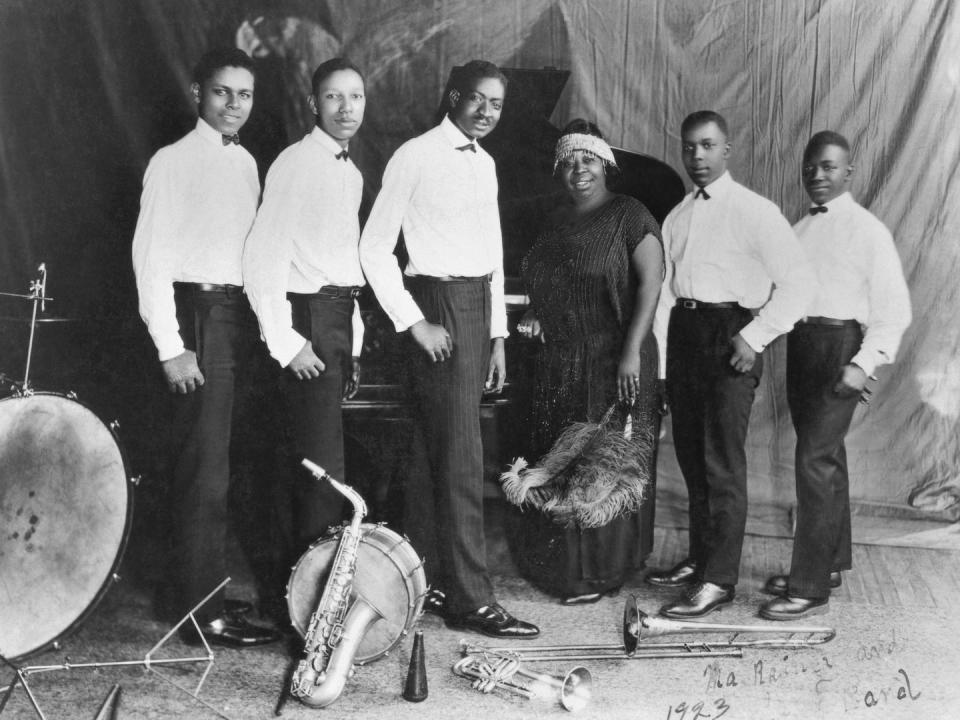The True Story Behind Viola Davis' Character in 'Ma Rainey's Black Bottom'

Last December, Netflix released the film Ma Rainey's Black Bottom, a drama adapted from a play of the same name written by late Pulitzer-winning playwright August Wilson. Produced by Denzel Washington and starring Viola Davis, the movie centers around real-life blues pioneer Gertrude "Ma" Rainey on the day that she and her band record a song called "Ma Rainey’s Black Bottom."
Watching Viola depict Ma, it's clear the Oscar-winning actress did a lot of preparation. Although Viola worried she wouldn't be able to sing well enough to play the iconic "Mother of Blues," after reading the script she knew she had to get involved.
"I think that [August] captures our humor as Black people," she told CBS News. "He captures our humor, our vulnerability, our tragedies, our trauma. And he humanizes us. And he allows us to talk."
Viola's portrayal of Ma has earned her a Golden Globe nomination, Screen Actors Guild award, and an Oscar nomination. Her costar, the late Chadwick Boseman, has picked up many awards and nods this season for his role, including a Golden Globe, a Screen Actors Guild award, and an Oscar nomination.

So, who is the real Ma Rainey?
Like Viola, the real Ma Rainey was an incredibly gifted performer. Ma was born Gertrude Pridgett in the South under Jim Crow laws to her mother, Ella, and father, Thomas. Though, per The Guardian, records suggest Ma was born in Alabama in September of 1882, the singer herself often said she was born on April 26, 1886 in Columbus, Georgia.

When she was just a teenager, Gertrude started traveling with vaudeville acts, which New York Times jazz critic Giovanni Russonello describes as "cabaret-like shows that developed out of minstrelsy in the mid-1800s and catered largely to white audiences." Per the critic, legend has it that during a visit to Missouri in 1902, Gertrude first heard a country blues singer. Inspired by the performer, she allegedly started singing the same song as an encore at her own shows.
Soon after, in 1904, Ma married her husband, William "Pa" Rainey. The New York Times reports that the duo eventually became known as "Ma and Pa Rainey, the Assassinators of the Blues." They would travel from town to town with the popular Rabbit Foot Minstrels (around this time, famous blues singer Bessie Smith got her start singing as one of Ma's performers).
After separating from William in 1916, Ma started her own performing company called Madam Gertrude Ma Rainey and Her Georgia Smart Set, and she continued to grow in popularity. In 1923, Ma became one of the first Black artists signed to Paramount, and she made her first of roughly 100 recordings. During this time, she brought massive blues hits like "Moonshine Blues," "See See Rider," and "Trust No Man" to the mainstream.
For much of the 1920s, Ma lived in Chicago and performed at house parties and concerts around the city while recording tracks for Paramount. By 1927 — a.k.a. the year Ma Rainey's Black Bottom is set in — Ma was in her forties and had already made recordings with various musicians under the name Ma Rainey and Her Georgia Jazz Band, including music giants such as Willie "The Lion" Smith and Louis Armstrong. According to A&E, she recorded her last session in 1928, producing songs such as "Black Eye Blues," "Sleep Talking Blues," and "Runaway Blues." After this, The Guardian reports that Paramount ended up canceling her recording contract "because her style of blues was no longer deemed fashionable."

Ma was still performing in the early 1930s, but after officially quitting show business in 1935, she returned to Columbus, Georgia to run two entertainment venues and participate in church activities. Sadly, just years after her retirement began, Ma died of a heart attack on December 22, 1939.
According to a New York Times obituary published in 2019 for its "Overlooked" series highlighting luminaries whose deaths went unreported in the paper, Ma was the first entertainer to "bridge the divide" between vaudeville and "authentic Black Southern folk expression." Ma is also credited for breaking new ground through the narratives told in her songs, as several of the tunes feature strong feminist elements in the lyrics, as Angela Davis noted in Blues Legacies and Black Feminism.

Her legacy as an LGBTQ pioneer also continues to be celebrated. Per Rolling Stone, Ma is hailed as a queer icon for being so open about her attraction to both men and women in her songs, though she never publicly identified as bisexual. In his play, August made sure to celebrate Ma's sexuality (including her rumored relationships with her female dancers and with Bessie Smith) with the inclusion of the fictional character Dussie Mae, portrayed by Taylour Paige in the Netflix movie.
Though her music temporarily fell out of print when the Great Depression hit and Paramount closed down, her catalog was revived in the 1960s when the songs were picked up by Milestone and Biograph labels, per The New York Times. During the Black Arts Movement of the '60s, poet Al Young famously wrote "A Dance for Ma Rainey," to honor her artistry.
In the 1980s, Ma was front and center in pop culture once again thanks to the Broadway staging of Ma Rainey's Black Bottom, starring Theresa Merritt as the acclaimed singer (in the 2003 revival, Whoopi Goldberg portrayed Ma). Around the same time, Sandra R. Lieb published a book about Ma's life titled Mother of the Blues: A Study of Ma Rainey.
During the '80s and '90s, Ma's contributions to music continued to be recognized. She was inducted into both the Blues Hall of Fame in 1983 and the Rock and Roll Hall of Fame in 1990, and honored with a U.S. Postal Service commemorative stamp in 1994. In 2004, her hit "See See Rider" was inducted into the Grammy Hall of Fame and added to the Library of Congress National Recording Registry.
Most recently, in 2017, the Rainey McCullers School of Arts in Columbus, Georgia was named after both Ma and novelist Carson McCullers.
Is Netflix's Ma Rainey's Black Bottom based on a true story?
All of the events that unfold in the Netflix movie — which shows a day in the life of Ma Rainey and her band — did not actually happen quite as depicted. While Ma did live in Chicago in 1927, had relationships with women, and traveled with a band, all of the characters in the play — Dussie Mae (Taylour Paige), Butler (Colman Domingo), Slow Drag (Michael Potts), Toledo (Glynn Turman), Sylvester (Dusan Brown), Sturdyvant (Jonny Coyne), and Levee (Chadwick Boseman) — are fictional.

That said, there are some real historical elements highlighted in the play. For instance, the song Ma is seen recording with her band, "Ma Rainey's Black Bottom," was an actual number written in response to the 1920s dance craze known as the black bottom, which originated in the Southern Black community (and was reportedly named after a predominantly Black neighborhood in Detroit). When the black bottom exploded in popularity during the Roaring Twenties, several artists, including Ma, recorded dance tracks for it.
The stories highlighted in Ma Rainey's Black Bottom are also based on the real experiences of Black Americans in the early 20th century. The exploitation of Black artists was widely prominent at the time of Ma's popularity. Per Robert Springer's "Folklore, Commercialism and Exploitation: Copyright in the Blues" and History.com, it was common practice for white-owned record labels to get Black artists to sign away their recording rights (and then have white artists release covers of their songs), underpay Black artists, and make it difficult for Black artists to receive the royalties they earned.
Ma Rainey's Black Bottom is actually one of several works included in August's American Century Cycle collection. To depict the Black experience throughout the 20th century, August penned a play for each decade — Ma Rainey's Black Bottom was set in the 1920s, The Piano Lesson was in the '30s, and Fences (both Denzel and Viola starred in the 2016 film version of the play) was in the '50s.
In an article for The New York Times before his death in 2005, the legendary dramatist wrote:
"I wanted to place this culture onstage in all its richness and fullness and to demonstrate its ability to sustain us in all areas of human life and endeavor and through profound moments of our history in which the larger society has thought less of us than we have thought of ourselves."

To honor August, Denzel made it known that he intends to bring all 10 of the American Century Cycle plays to the big screen in the years to come.
"We're going to do one a year for the next nine years. I'm really excited about that," he told The Hollywood Reporter. "That they put it in my hands, the estate, and trust me. That's good enough for me. It doesn't get any better than that."
You Might Also Like


